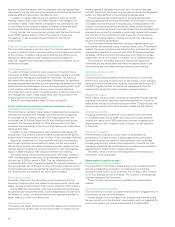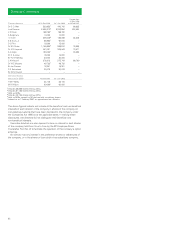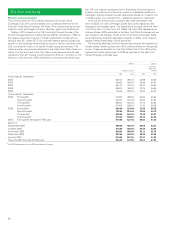BP 2006 Annual Report Download - page 78
Download and view the complete annual report
Please find page 78 of the 2006 BP annual report below. You can navigate through the pages in the report by either clicking on the pages listed below, or by using the keyword search tool below to find specific information within the annual report.
76
Governance: board performance report
Governance and the role of our board
Governance is the system by which the company’s owners and their
representatives on the board ensure that the company pursues its defined
purpose and only allocates resources to that purpose. It is neither a
process of compliance nor an additional level of management. The
board’s activity is focused on this task as the representative of BP’s
owners and it discharges this through actions that promote long-term
shareholder interest.
BP’s approach to governance is based on the connection between
good governance and maximizing shareholder value. We believe that good
governance involves both clarity of roles and distinct skills and processes.
The BP board governs the company on behalf of shareholders, while
management is delegated to the group chief executive through the board
governance policies. These policies use a coherent, principles-based
approach that ensures our board and management operate within a clear
and efficient governance framework that places long-term shareholder
interest at the centre of everything the company does.
In maximizing long-term shareholder interest, the board exercises
judgement when carrying out its work in policy-making, monitoring
executive action and active consideration of group strategy. While being
responsible to shareholders, the board also recognizes the need to be
responsive to the interests of those with whom the company interacts.
Shareholders
Accountability
The board, principally through the AGM, is accountable to shareholders
for the performance and activities of the entire BP group. The board
takes steps to understand shareholder preferences and to evaluate
systematically the financial, social, environmental and ethical matters
that may influence or affect the interests of our shareholders.
Dialogue
Throughout the year, the chairman has regular meetings with institutional
shareholders to discuss issues of governance and high-level strategy.
Shareholder dialogue is also undertaken by the group chief executive and
other directors, the company secretary’s office, investor relations and
other teams within BP on wider issues relating to the operation and
financial performance of the company. Presentations given by the
company to the investment community are available on the ‘Investor’
section of www.bp.com.
Reporting
BP uses a number of different reporting channels to provide feedback
and accountability on the company’s performance to shareholders. These
include the Annual Report and Accounts (which now includes a business
review), Annual Review, Annual Report on Form 20-F and announcements
made through stock exchanges on which BP shares are listed, as well as
the AGM. BP seeks to promote the use of electronic communications
within its reporting methods, so all these documents are available via our
website at www.bp.com.
AGM and voting
Shareholders are encouraged to attend the AGM and use the opportunity
to ask questions and hear the resulting discussion about BP’s
performance. However, given the size and geographical diversity of the
company’s shareholder base, we recognize that this may not always be
practical and shareholders who are unable to attend are encouraged to
use proxy voting on the resolutions put forward. Every vote cast, whether
in person or by proxy at shareholder meetings, is counted, because votes
on all matters except procedural issues are taken by a poll. The company
has introduced a ‘vote withheld’ option on the proxy form in order to
comply with the revised UK Combined Code. A ‘vote withheld’ is not a
vote in law and will not be counted in the calculation of the proportion of
votes ‘for’ and ‘against’ a resolution.
After the event, copies of speeches and presentations given at the
AGM are available to download via www.bp.com, together with the
outcome of voting on the resolutions.
The chairman and the board committee chairmen were present during
the 2006 AGM. Board members also met shareholders informally after
the main business of the AGM. In 2006, voting levels at the AGM
increased to 64%, up from 62% in 2005.
Election of directors
All directors stand for re-election each year, with new directors being
subject to election at the first opportunity following their appointment.
All the names submitted to shareholders for election are accompanied
by a biography and an outline of the skills and experience that the
company feels are relevant in proposing them for the office of director.
Voting levels from the 2006 AGM demonstrated continued support
for all our directors.
How the board governs the company
The board’s governance policies describe its relationship with
shareholders, the conduct of board affairs and the board’s relationship
with the group chief executive. The policies recognize the board’s
separate and unique role as the link in the chain of authority between
the shareholders and the group chief executive. It is this unique task
that gives the board its central role in governance.
The board governance policies address the dual role played by the
group chief executive and executive directors as both members of the
board and leaders of executive management. The policies require a
majority of the board to be composed of independent non-executive
directors. To assure the integrity of the governance process, the
relationship between the board and the group chief executive is governed
by the non-executive directors, particularly through the work of the board
committees they populate.
The board focuses on those tasks that are unique to it as a board,
reserving to itself the making of broad policy decisions. It delegates
detailed consideration to either board committees and officers (for board
processes) or to the group chief executive (in the case of management of
the company’s business activities). The board governs BP through setting
general policy for the conduct of business (and, critically, by clearly
articulating its goals) and by monitoring its implementation by the group
chief executive.
To discharge its governance function effectively, the board has laid
down rules for its own activities in a governance process policy.
Responsibility for implementing this policy is placed on the chairman.
This policy covers:
– The conduct of members at meetings.
– The cycle of board activities and the setting of agendas.
– The provision of timely information to the board.
– Board officers and their roles.
– Board committees, their tasks and composition.
– Qualifications for board membership and the process of the
nomination committee.
– The evaluation and assessment of board performance.
– The remuneration of non-executive directors.
– The process for directors to obtain independent advice.
– The appointment and role of the company secretary.
The delegation of authority from the board to the group chief executive
and the expectations and limitations on that authority are set out in three
separate board governance policies, which enables the board to shape
BP’s values and standards:
1. Board-executive linkage policy, which outlines how the board delegates
authority to the group chief executive and the extent of that authority.
It also sets out how the performance of the group chief executive will
be monitored.
2. Board goals policy, which clarifies what the board expects the group
chief executive to deliver.
























